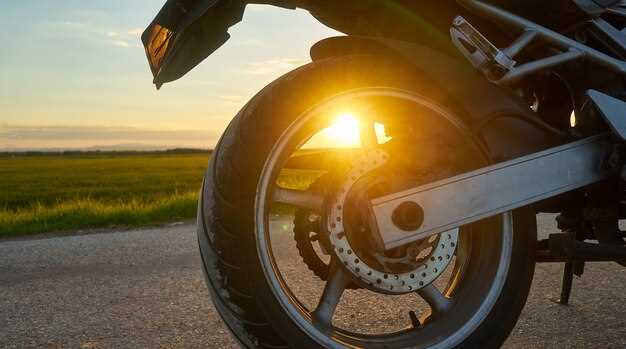
Motorcycle tires are crucial for ensuring safety and performance on the road. Over time, wear and tear can significantly impact their effectiveness, making it essential for riders to remain vigilant about tire condition. Recognizing the signs indicating it’s time for a tire change can prevent dangerous situations and enhance your riding experience.
One of the primary factors to consider is the tread depth of your motorcycle tires. Inadequate tread can lead to poor grip, especially in wet conditions. If you notice the tread pattern becoming less pronounced or if the wear indicators are visible, it’s a clear signal that a tire replacement is necessary. Additionally, keep an eye out for any cracks or bulges in the tire sidewalls, which can compromise structural integrity.
Other indicators include unusual vibrations or instability while riding. If your motorcycle feels unsteady or pulls to one side, it may be time to change your tires. Regularly inspecting your tires and being attentive to these signs will help maintain not just your safety but also your overall riding enjoyment.
Assessing Tread Depth for Optimal Grip
Ensuring your motorcycle tires provide optimal grip starts with regular assessment of tread depth. Tread serves a critical function, channeling water away and maintaining contact with the road. Insufficient tread can significantly reduce traction, especially in wet or uneven conditions. Therefore, monitoring the depth is essential for safety and performance.
A common method to assess tread depth is utilizing a tread depth gauge, which accurately measures how much tread remains on your tires. For most motorcycle tires, a depth of 1.6 mm is considered the minimal threshold for safe riding. If your measurements fall below this point, it is time to change the tires.
You can also use the penny test as a quick visual check. Insert a penny into the tread with Lincoln’s head facing down. If you can see the top of Lincoln’s head, the tread is too worn, indicating a need for new tires to maintain proper grip.
Regularly checking tire pressure in conjunction with tread depth can also impact grip performance. Under-inflated tires can wear unevenly, decreasing overall tread life. Ensuring you follow manufacturer recommendations for both tire pressure and tread depth will guarantee the best possible grip, ultimately enhancing your riding experience.
Identifying Sidewall Damage and Wear Patterns

Understanding the condition of your motorcycle tires is crucial for ensuring safety and performance. The sidewall of a tire plays a significant role in providing grip and stability. Identifying damage or wear patterns can help signal when it’s time to consider a tire replacement.
Here are some common signs of sidewall damage:
- Cuts and Gouges: Inspect the sidewall for any visible cuts or gouges. Even minor cuts can compromise the structural integrity of the tire and affect grip.
- Bubbles and Blisters: Look for any bulging areas. These bubbles indicate air has penetrated through the tire, leading to potential failure.
- Cracking: Check for severe cracks, particularly around the bead area where the tire meets the rim. Cracking can result from age, UV exposure, and wear, ultimately reducing grip.
- Wear Patterns: Analyze the tread and sidewall for uneven wear. Patterns may indicate misalignment, under-inflation, or over-inflation, affecting both handling and grip.
To assess wear patterns effectively, consider the following steps:
- Visual Inspection: Regularly examine the entire tire, focusing on the sidewall. Make it a habit to perform this check every time you clean your bike.
- Tire Pressure Check: Maintaining correct tire pressure is essential for even tire wear. Under-inflated tires can lead to more pronounced sidewall damage.
- Test Ride: Pay attention to how your motorcycle handles. Any significant changes in grip or stability during turns may suggest tire issues.
In conclusion, being proactive in identifying sidewall damage and wear patterns is vital for maintaining your motorcycle’s performance and safety. Regular inspections not only prolong tire life but also ensure that your bike provides the grip and handling necessary for a safe riding experience.
Understanding the Impact of Age on Tire Performance

Tire age plays a crucial role in overall performance and safety. As motorcycle tires age, their rubber compounds can harden and lose flexibility, significantly affecting traction and grip. This change can lead to longer stopping distances and diminished handling characteristics, making it essential for riders to pay close attention to the age of their tires.
Most manufacturers recommend replacing tires every 5 to 6 years, regardless of tread wear. This is due to the degradation of materials over time, which may not be visible on the surface. The performance of tires is not solely dependent on their tread depth; the internal structure and rubber quality deteriorate with age, leading to potential failure during critical riding conditions.
Riders should regularly check the manufacturing date printed on the tire’s sidewall. Even if the tread appears adequate, older tires can compromise grip, especially in wet or slippery conditions. Therefore, assessing both age and physical condition is vital for ensuring safe rides.
In summary, understanding the impact of age on tire performance is essential for maintaining safety and optimizing performance. Timely tire replacement can enhance grip, improve responsiveness, and ultimately provide a better overall riding experience.
